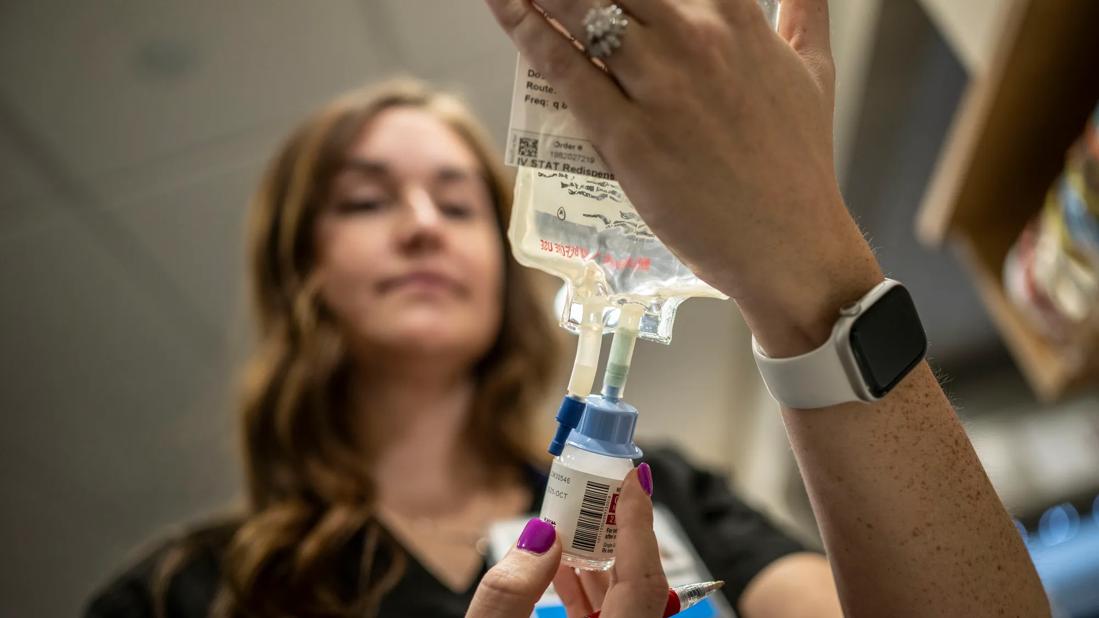No notable difference in reactions with two-hour infusion in ENSEMBLE PLUS substudy

Reducing the infusion time of ocrelizumab to just two hours for the treatment of early relapsing-remitting multiple sclerosis (RRMS) leads to similar frequency and severity of infusion-related reactions as infusing over the conventional duration of 3.5 hours. That’s the conclusion of investigators with the completed ENSEMBLE PLUS substudy as reported by Robert Bermel, MD, Director of Cleveland Clinic’s Mellen Center for Multiple Sclerosis Treatment and Research, in a poster presentation at the American Academy of Neurology 2023 annual meeting.
Advertisement
Cleveland Clinic is a non-profit academic medical center. Advertising on our site helps support our mission. We do not endorse non-Cleveland Clinic products or services. Policy
“Reducing infusion time offers benefits both to patients and to infusion staff,” says Dr. Bermel, who is on steering committees for the ENSEMBLE and ENSEMBLE PLUS multicenter trials. “As a result of these findings, we have made the shorter infusion schedule our default at Cleveland Clinic.”
He adds that the final results from ENSEMBLE PLUS are expected to be published shortly.
ENSEMBLE (NCT03085810) is an ongoing prospective, multicenter, single-arm, phase 3b study designed to evaluate the effectiveness and safety of ocrelizumab in early RRMS. The open-label treatment period will last 192 weeks, with at least 48 weeks of follow-up. The trial enrolled 1,239 patients and is expected to be completed in August 2024.
Ocrelizumab, a second-generation recombinant humanized monoclonal that targets B cells, was approved for the treatment of primary progressive and relapsing MS in 2017.
The drug is administered intravenously as two 300-mg infusions on days 1 and 15, followed by one 600-mg infusion dose administered over about 3.5 hours (the conventional infusion time) every 24 weeks for a maximum of eight doses.
The optional substudy reported here — ENSEMBLE PLUS — used a randomized, double-blind design to evaluate the safety of shorter versus conventional infusion of ocrelizumab.
After the first two 300-mg infusions, 745 patients were randomized to receive the remaining doses of 600 mg infused either at the conventional rate or a reduced rate (about two hours, followed by saline infusion over the remaining 1.5 hours to mimic the conventional infusion).
Advertisement
The conventional group (N = 373) and the reduced infusion group (N = 372) were similar in age, sex, weight, body mass index and time since first MS symptoms.
Primary analyses of the ENSEMBLE PLUS results were previously published in Multiple Sclerosis and Related Disorders (2020;46:102492) and in Neurology: Neuroimmunology & Neuroinflammation (2020;7[5]:e807). They indicated that conventional and shorter ocrelizumab infusion periods had similar frequency, severity and symptoms of infusion-related reactions.
The current report highlights the following results:
Dr. Bermel also emphasized the following overall trends:
Advertisement
This was the first report to provide evidence of patient preference for the shorter infusion strategy. Following unblinding of the ENSEMBLE PLUS substudy, patients could choose to switch their infusion regimen. The vast majority chose to either remain with the shorter infusion group or change to it. After the choices were made, just 90 patients were undergoing treatment with the conventional infusion time versus 610 with the reduced infusion time.
Dr. Bermel notes that Cleveland Clinic now routinely infuses ocrelizumab over two hours, regardless of MS stage. The study results led to an FDA-approved label change for ocrelizumab, allowing for the two-hour infusion time for patients who have not had a previous serious infusion reaction with the drug.
“Patients who have had a previous infusion-related reaction should receive infusions in a hospital-based infusion center so they can be monitored more carefully,” Dr. Bermel emphasizes. “They should not use stand-alone infusion centers without physician supervision on the premises.”
Advertisement
Advertisement

Case-control study yields evidence of epigenetic aging in pediatric-onset MS

Novel insights from a postmortem study combining imaging, pathology and clinical perspectives

Long-awaited efficacy against disability progression in nonrelapsing SPMS appears to be at hand

Extension of DELIVER-MS trial will clarify long-term clinical effects of dueling treatment philosophies

BTK inhibitor tolebrutinib shows positive results in phase 3 HERCULES trial

No effect on symptom severity or disability, and low prevalence of long COVID

Using multidisciplinary care to address mood changes, mitigate daily stressors

MRI classifier identifies a subset of patients with disease marked by cortical atrophy, not demyelination